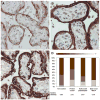Microarray profiling reveals that placental transcriptomes of early-onset HELLP syndrome and preeclampsia are similar
- PMID: 20541258
- PMCID: PMC3917714
- DOI: 10.1016/j.placenta.2010.04.014
Microarray profiling reveals that placental transcriptomes of early-onset HELLP syndrome and preeclampsia are similar
Abstract
Background: The involvement of the placenta in the pathogenesis of preeclampsia and HELLP syndrome is well established, and placental lesions are also similar in these two syndromes. Here we aimed to examine the placental transcriptome and to identify candidate biomarkers in early-onset preeclampsia and HELLP syndrome.
Methods: Placental specimens were obtained at C-sections from women with early-onset preeclampsia and HELLP syndrome, and from controls who delivered preterm or at term. After histopathological examination, fresh-frozen placental specimens were used for microarray profiling and validation by qRT-PCR. Differential expression was analysed using log-linear models while adjusting for gestational age. Gene ontology and pathway analyses were used to interpret gene expression changes. Tissue microarrays were constructed from paraffin-embedded placental specimens and immunostained.
Results: Placental gene expression was gestational age-dependent among preterm and term controls. Out of the 350 differentially expressed genes in preeclampsia and 554 genes in HELLP syndrome, 224 genes (including LEP, CGB, LHB, INHA, SIGLEC6, PAPPA2, TREM1, and FLT1) changed in the same direction (elevated or reduced) in both syndromes. Many of these encode proteins that have been implicated as biomarkers for preeclampsia. Enrichment analyses revealed similar biological processes, cellular compartments and biological pathways enriched in early-onset preeclampsia and HELLP syndrome; however, some processes and pathways (e.g., cytokine-cytokine receptor interaction) were over-represented only in HELLP syndrome.
Conclusion: High-throughput transcriptional and tissue microarray expression profiling revealed that placental transcriptomes of early-onset preeclampsia and HELLP syndrome largely overlap, underlying a potential common cause and pathophysiologic processes in these syndromes. However, gene expression changes may also suggest a more severe placental pathology and pronounced inflammatory response in HELLP syndrome than in preeclampsia.
Copyright © 2010 Elsevier Ltd. All rights reserved.
Conflict of interest statement
The authors have no conflict of interest.
Figures



Similar articles
-
Activation of villous trophoblastic p38 and ERK1/2 signaling pathways in preterm preeclampsia and HELLP syndrome.Pathol Oncol Res. 2015 Jul;21(3):659-68. doi: 10.1007/s12253-014-9872-9. Epub 2015 Jan 13. Pathol Oncol Res. 2015. PMID: 25583406 Free PMC article.
-
Transcriptome analysis of placentae reveals HELLP syndrome exhibits a greater extent of placental metabolic dysfunction than preeclampsia.Hypertens Pregnancy. 2021 May;40(2):134-143. doi: 10.1080/10641955.2021.1908348. Epub 2021 Apr 5. Hypertens Pregnancy. 2021. PMID: 33818250
-
Increased placental expression of Placental Protein 5 (PP5) / Tissue Factor Pathway Inhibitor-2 (TFPI-2) in women with preeclampsia and HELLP syndrome: Relevance to impaired trophoblast invasion?Placenta. 2019 Jan 15;76:30-39. doi: 10.1016/j.placenta.2019.01.011. Epub 2019 Jan 19. Placenta. 2019. PMID: 30803712
-
Genetic aspects of preeclampsia and the HELLP syndrome.J Pregnancy. 2014;2014:910751. doi: 10.1155/2014/910751. Epub 2014 Jun 2. J Pregnancy. 2014. PMID: 24991435 Free PMC article. Review.
-
Molecular genetics of preeclampsia and HELLP syndrome - a review.Biochim Biophys Acta. 2012 Dec;1822(12):1960-9. doi: 10.1016/j.bbadis.2012.08.004. Epub 2012 Aug 16. Biochim Biophys Acta. 2012. PMID: 22917566 Review.
Cited by
-
Integrated Systems Biology Approach Identifies Novel Maternal and Placental Pathways of Preeclampsia.Front Immunol. 2018 Aug 8;9:1661. doi: 10.3389/fimmu.2018.01661. eCollection 2018. Front Immunol. 2018. PMID: 30135684 Free PMC article.
-
Identifying preeclampsia-associated genes using a control theory method.Brief Funct Genomics. 2022 Jul 27;21(4):296-309. doi: 10.1093/bfgp/elac006. Brief Funct Genomics. 2022. PMID: 35484822 Free PMC article.
-
Proteoglycans: Systems-Level Insight into Their Expression in Healthy and Diseased Placentas.Int J Mol Sci. 2022 May 21;23(10):5798. doi: 10.3390/ijms23105798. Int J Mol Sci. 2022. PMID: 35628608 Free PMC article. Review.
-
IGFBP-4 and -5 are expressed in first-trimester villi and differentially regulate the migration of HTR-8/SVneo cells.Reprod Biol Endocrinol. 2014 Dec 4;12:123. doi: 10.1186/1477-7827-12-123. Reprod Biol Endocrinol. 2014. PMID: 25475528 Free PMC article.
-
Innate and Adaptive Immune Responses in HELLP Syndrome.Front Immunol. 2020 Apr 15;11:667. doi: 10.3389/fimmu.2020.00667. eCollection 2020. Front Immunol. 2020. PMID: 32351511 Free PMC article. Review.
References
-
- Weinstein L. Syndrome of hemolysis, elevated liver enzymes, and low platelet count: a severe consequence of hypertension in pregnancy. Am J Obstet Gynecol. 1982;142:159e67. - PubMed
-
- Ness RB, Roberts JM. Heterogeneous causes constituting the single syndrome of preeclampsia: a hypothesis and its implications. Am J Obstet Gynecol. 1996;175:1365e70. - PubMed
-
- Romero R. Prenatal medicine: the child is the father of the man. Prenat Neonatal Med. 1996;1:8e11. - PubMed
-
- Roberts JM, Lain KY. Recent insights into the pathogenesis of pre-eclampsia. Placenta. 2002;23:359e72. - PubMed
-
- von Dadelszen P, Magee LA, Roberts JM. Subclassification of preeclampsia. Hypertens Pregnancy. 2003;22:143e8. - PubMed
Publication types
MeSH terms
Grants and funding
LinkOut - more resources
Full Text Sources
Other Literature Sources
Research Materials
Miscellaneous

